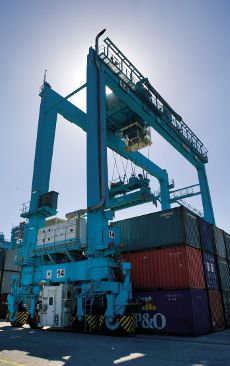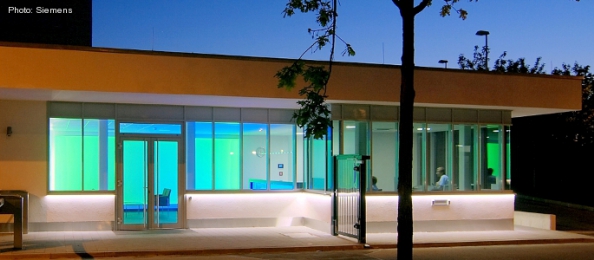Climate Protection – For the Customer and in the Factory
Climate protection is a global challenge. To meet it, responsible industrial companies must take a holistic approach that combines innovative products for their customers with eco-friendly systems at their own production facilities. A look at Tangier, Morocco, and Regensburg, Germany, shows how this approach works in practice.
Tangier: At one of the largest ports for container ships in North Africa, a giant crane lifts containers from a storage area on the dock and lowers them one by one onto waiting trucks – a common sight at container ports around the world. Only this time there is a difference. The crane in Tangier consumes only half as much energy as its conventional counterparts. The result: less damage to the environment from CO2 emissions and lower costs for the operator.
How is this possible? Siemens – together with Danish port operator APM Terminals – has developed a process that enables container cranes to recover the energy released when loads are lowered and recycle it back into their own energy supply systems. Sophisticated software – developed in cooperation with Delft Technical University especially for this energy management system – cuts energy consumption and turns conventional RTG (rubber-tired gantry) cranes into advanced ECO RTGs that meet the requirements of both modern global freight transport and active environmental and climate protection.
Today, 26 container cranes in the port of Tangier are equipped with this innovative Siemens technology. There are another 28 ECO RTGs in operation in the Spanish harbor of Algeciras on the European side of the Straits of Gibraltar and more than 100 in other parts of the world – including ports in China and India. And the number is increasingly constantly.

Photo: Siemens
Part of the Environmental Portfolio
The ECO RTG is part of Siemens’ Environmental Portfolio, which contains products and solutions along the entire energy conversion chain: from power generation to power distribution to energy consumption for both private households and industrial applications (see box). The Portfolio also boasts energy-efficient products and advanced water treatment and air pollution control systems.
In 2009, products and solutions from the Environmental Portfolio helped Siemens’ customers reduce their CO2 emissions by 210 million tons – an amount equal to the total annual emissions of New York, Tokyo, London, and Berlin, and 50 times the amount of CO2 that Siemens generates through its own business activities. Encouraged by these figures, the company has raised the bar for 2011. With its Environmental Portfolio, it wants to help customers cut their CO2 emissions by the end of next year not, as previously planned, by some 275 million tons but by a whopping 300 million tons – roughly the same amount of CO2 now generated by New York, Tokyo, London, Singapore, Hong Kong, and Rome combined. Siemens’ internal standards for environmentally compatible product development, innovations in growing “green” markets, as well as efficient communication with customers and suppliers are enablers to further increase energy efficiency of products and solutions and thus to reach these ambitious CO2-saving targets.
From monsters to micro-components
A change of scenery: from an international port in Morocco to one of the world’s most advanced factories in Germany – from giant cranes to tiny electronic components, so-called opto semiconductor chips. Only a few millimeters in size, these chips are the centerpiece of light-emitting diodes (LEDs), the innovative luminaries that are being increasingly used in dashboard instruments and car headlights, in architecture and street lighting, in traffic lights and display walls. The chips are produced in an OSRAM Opto Semiconductors facility opened in Regensburg in 2003.
Here we meet Martin Stange, head of the facility’s plant management. Standing in front of a green, head-high machine, he explains to a group of environmental officers from other OSRAM locations how the device works. It is an absorption refrigerator. “Using the hot exhaust air generated in the emission control process, the machine converts hot exhaust gases, which have a temperature of 120oC, into the ‘cold’ needed to drive the cooling system,” says Stange. This saves the energy that would otherwise be required for refrigeration.
The absorption refrigerator is part of a holistic energy concept for optimizing energy efficiency at the Regensburg facility. The concept was developed while the plant was still in the planning phase and then rigorously implemented during construction. The results are impressive: annual energy savings of roughly 17.5 million kilowatt-hours, which would be generated otherwise by gas and electricity, and a 5,200-ton reduction in environmentally harmful CO2 emissions.
But the concept not only benefits the environment. The cost of its implementation – €1.7 million – was recouped in just two years.
Ideas like the holistic energy concept in Regensburg are some of the reasons why the greenhouse gas emissions at Siemens’ production facilities are very small compared to those at other industrial companies. In 2008, the company’s CO2 emissions totaled 4 million tons – an 8 percent decrease over the year before.
But that is no reason to sit back and relax. Further progress is essential. For Siemens’ production facilities worldwide, this means intensifying the focus on climate protection. By 2011, the company intends to raise its environmental performance in the areas of energy efficiency and CO2 emissions by 20 percent on a revenue-adjusted basis.
The big picture
The further development of the Environmental Portfolio and improvements in operational environmental protection at production facilities are part of Siemens’ current Environmental Program, which – by cutting energy consumption and CO2 emissions – is also a climate protection program. The monsters in Tangier and the production of micro-components in Regensburg are both examples of how this program, which is supported by worldwide environmental management and monitoring, works in practice: climate protection for the customer and in production – with the help of its holistic approach, the Siemens Environmental Program aims to achieve both.
The Siemens Environmental Program
The goals of the Siemens Environmental Program for 2011 include:
- establishing a comprehensive structure for the existing environmental management system improving
- environmental performance in the areas of energy, CO2, and water by 20 percent and in the area of waste management by 15 percent on a plant-specific, revenue-adjusted basis
The Siemens Environmental Portfolio
Siemens’ Environmental Portfolio comprises outstanding products and solutions that make a direct, verifiable contribution to environmental and climate protection. These offerings include:
- products and solutions that are substantially more energy efficient than comparable solutions (for example, the average of the installed base);
- systems and components for utilizing renewable energies;
- environmental technologies for water treatment and air pollution control.
In 2009, the Portfolio generated revenue of €23 billion. The goal is to achieve €25 billion in revenue by 2011. As in previous years, its methods and data were reviewed by independent auditors PricewaterhouseCoopers.
This project description was originally presented in the Global Compact International Yearbook 2010.
Dr. Bloch lives in Germany and works for Siemens.
Mr Pfitzner works with Siemens in Germany.
About Us // Privacy Policy // Copyright Information // Legal Disclaimer // Contact
Copyright © 2012-2018 macondo publishing GmbH. All rights reserved.
The CSR Academy is an independent learning platform of the macondo publishing group.









